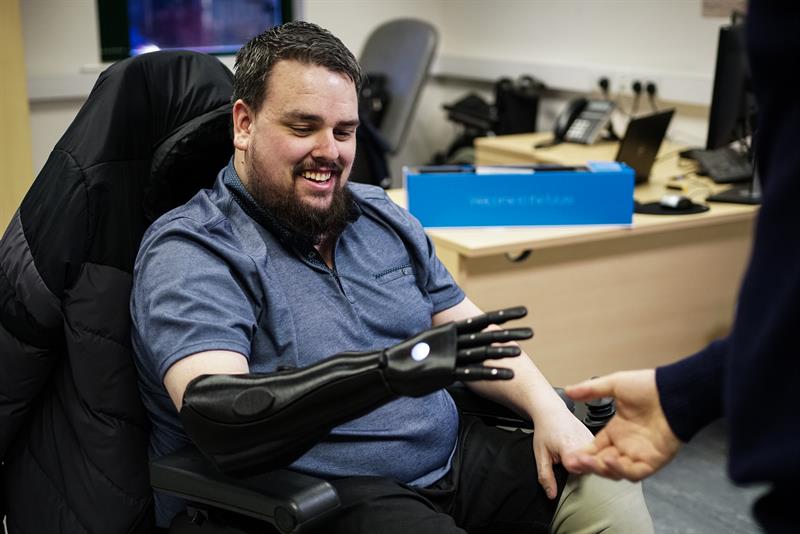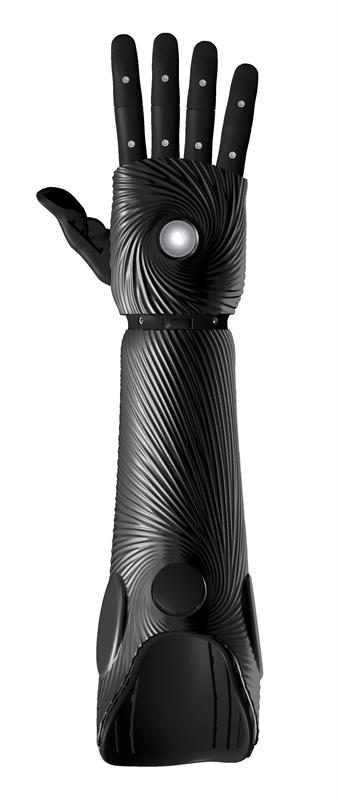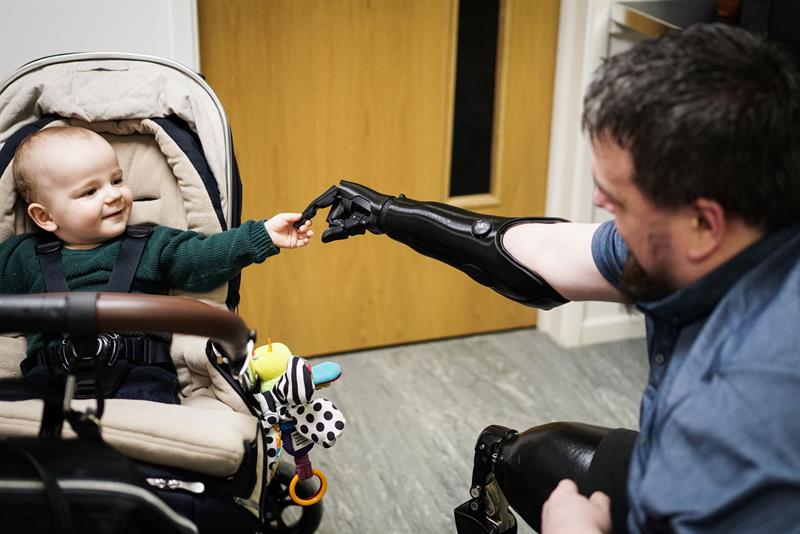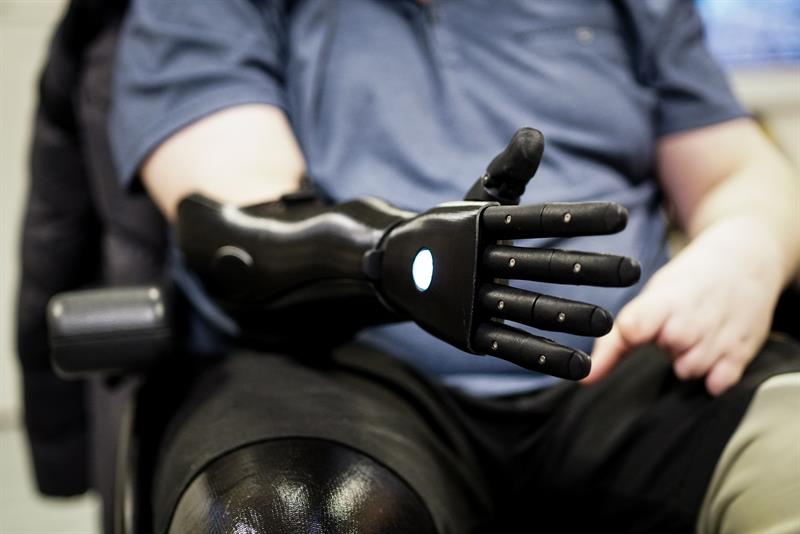At the age of five, Danny Florence lost both legs, a hand and most of his fingers. “I remember always being outside on my bike or my rollerblades and one day my ankle started hurting. I went to bed and during the night began to hallucinate and my body started spasming,” Danny had contracted meningitis.
Danny was put into an induced coma and doesn’t remember anything until he woke some eight weeks later. During that time doctors had to amputate his limbs to save his life. He had to learn how to talk and drink again and get used to the pain. When he became aware he had lost his legs his first thought was that he wouldn’t be able to ride his bike again.
Danny explains, “Mum took me to the hospital every day for two years to have physiotherapy as part of my rehabilitation. The doctors gave me basic leg prosthetics after three months and, after a while, I learnt to walk with them. These days I use a powered wheelchair as I can’t walk far. I didn’t do anything about my lack of a hand until I reached eleven or twelve and became self-conscious about it.”
 Unfortunately, the hospital could only offer two options; a body-powered prosthetic with a gripper or a ‘mannequin-like’ hand with no functionality. After a couple of days wearing the heavy passive prosthesis, Danny decided to stop using it. “It looked worse than not having a hand,” he said.
Unfortunately, the hospital could only offer two options; a body-powered prosthetic with a gripper or a ‘mannequin-like’ hand with no functionality. After a couple of days wearing the heavy passive prosthesis, Danny decided to stop using it. “It looked worse than not having a hand,” he said.
“I’ve always managed well with only one hand but when my son Joshua came along ten months ago, I realised how much more I could do with two.” Danny, and his partner Danielle, had anticipated having issues with dexterous tasks like nappy changing and getting the baby dressed, but Danny hadn’t realised how much not doing these things would affect the bond with his son.
Danny had heard of a company called Open Bionics. The Bristol-based company is a multi-award-winning designer and manufacturer of affordable prosthetic limbs and is responsible for producing the world’s first medically certified 3D-printed bionic arm.
 Bristol-based Open Robotics was founded by 2014 British Engineering Excellence Awards winner Joel Gibbard and Samantha Payne. The company is committed to developing affordable robotic systems that enhance the human body. According to the company, the main areas where it has been able to innovate to achieve savings are cost; weight; size; style and control.
Bristol-based Open Robotics was founded by 2014 British Engineering Excellence Awards winner Joel Gibbard and Samantha Payne. The company is committed to developing affordable robotic systems that enhance the human body. According to the company, the main areas where it has been able to innovate to achieve savings are cost; weight; size; style and control.
The Hero Arm represents the latest stage in this process. It is the world’s first medically certified 3D-printed bionic arm, with multi-grip functionality and empowering aesthetics. Engineered and manufactured in Bristol, UK, the Hero Arm is a lightweight and affordable myoelectric prosthesis, available now in the USA, UK and France for below elbow amputee adults and children over eight.
Each Hero Arm is custom built using 3D printing and 3D scanning technologies. The prosthesis is robust, and the socket is comfortable, adjustable and breathable too, which means it’s easy to take on and off while providing the user with the best possible fit.
Even though the Hero Arm is powered by space grade motors, advanced software and long-lasting batteries, it is lightweight and super sleek. The hand, which comes in three sizes, is the lightest on the market. They are also very strong, being able to lift up to 8 kg (17.64 lbs).
Special sensors within the Hero Arm detect muscle movements, meaning users can effortlessly control their bionic hand with intuitive life-like precision. Also, haptic vibrations, beepers, buttons and lights provide intuitive notifications.
Open Bionics has worked with global DC drive manufacturer maxon since its inception in 2015. maxon designed and produced the actuator for the digits in the Hero Arm – each finger uses a maxon DCX 12 L motor. The actuator consists of a DC motor driving a customised gearbox and lead screw and nut, developed for the speed of each user.

As muscles generate electrical signals when they contract, they create movement when connected to the electrodes in the prosthetic. Adult hands use four DC motors and, as they are so much smaller, a child’s hand uses only three. As space is limited, Open Bionics chose maxon’s DCX 12mm as it is the most compact DC motor with the highest power density on the market. The company was also able to get samples quickly delivered by using the maxon online Configurator.
Although Open Bionics offer Hero Arms in various designs, including ones from Disney, Danny has opted to go for the sleek black cover to match his legs. “When I was younger, I was given skin-coloured tights and padding to make my legs look ‘real’, but they snagged a lot and it wasn’t practical. I used to park in the disabled bays and get abuse from people not realising I didn’t have any legs, now Iwear shorts all the time and don’t get any abuse.
“These days prosthetic designs look much better and all my nieces and nephews think I’m bionic!” Danny admits being terrified at how Joshua is going to react to his new hand. “He loves my prosthetic legs. He gets all excited and laughs when I put them on and likes to touch them.”

Danny has two hopes for his new hand; he wants to make the bond stronger between him and his son and, importantly, wants to increase the publicity for the hand itself.
“This technology should be offered to everyone. This is life-changing, not only for the obvious physical side but mentally as well. People who lose limbs can get very depressed, struggling with the ongoing pain and mourning the life they had before. They can even contemplate suicide. This hand has such huge benefits, it should be available on the National Health Service and I want to help the cause to make that happen.”
Danny had a socket fitting in November. The suitability of myoelectric control is determined by the fit between the stump and the prosthetic. Danny was surprised when he tried the arm for the first time, as he was able to work it straight away, even though it was using muscles that he hadn’t used for 21 years.
Danny said “I’ve been very excited and it’s better than I imagined. Seeing the arm, you get an overwhelming sense when you first see it. I then got to try it on and, like magic, I got it to work pretty much straight away. It’s amazing. It’s very smart. Previously I’ve had a very ugly static hand, and this is a very nice-looking hand.”
As well as being nice-looking, the hand offers a range of features and functionality. These include a posable wrist that can be rotated through 180 degrees; a posable thumb capable of picking up tiny objects; multiple easy-to-select grips giving great user control that can be reconfigured to the user’s preferences by their prosthetist; and a freeze mode that allows the hand to be held in a static position for no fuss, reliable grip such as when holding a glass.
Proportional control of the speed of the fingers allows for delicate tasks such as picking up an egg, while the arm’s long battery life gives all-day usage without needing to plug in and charge.
Bionic arms such as the Hero Arm work by picking up myoelectric signals from a user’s muscles. When a user puts on their bionic arm and flexes muscles in their residual limb just below their elbow; special sensors detect tiny naturally generated electric signals and convert these into intuitive and proportional bionic hand movement. The Arm has up to six different grips, and these are grouped in pairs to make switching between them quick and easy.
Danny explains “I wanted to get a Hero Arm a few years ago, but I decided at the time that I managed OK. But then, when I had my little boy, I realised there was a lot I couldn’t do, and that led me to actually do something about it. I started a Go Fund Me page. Many, many companies raised money - and many individuals - and for that, I’m always going to be grateful. Eventually, maxon got in touch and advised that they were going to sponsor it. That call was surreal. I’ll never forget it.”











